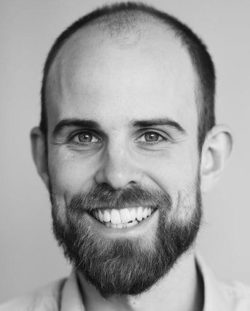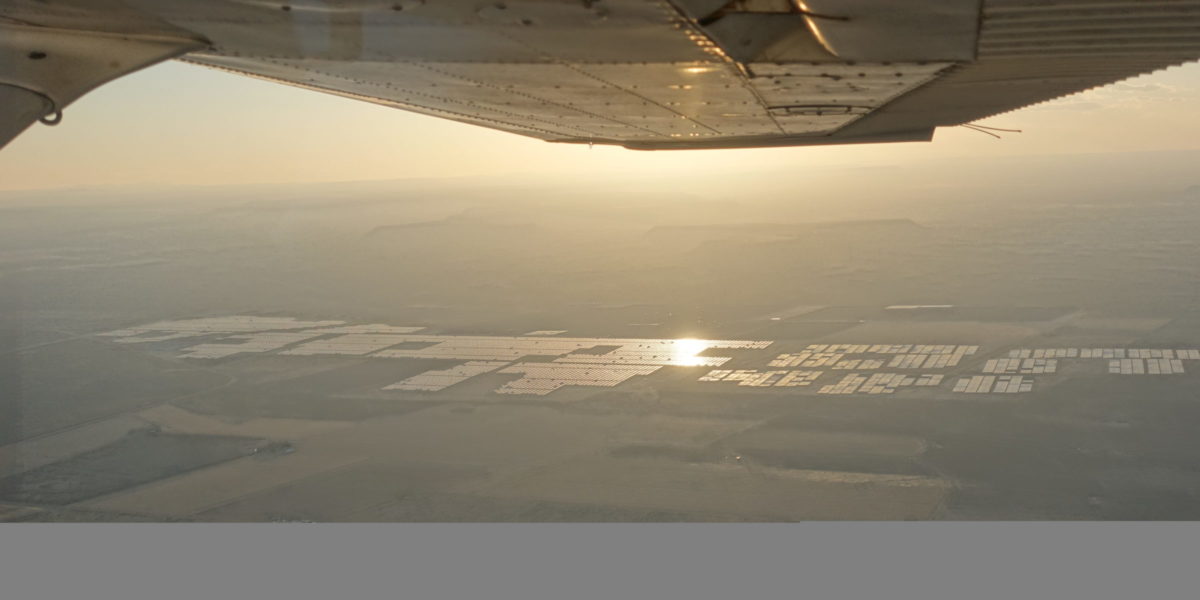pv magazine: For those not familiar with Heliolytics, can you talk about your aerial inspection services, and how those are used for solar site analysis?
 Dr. Rob Andrews: Heliolytics specializes in aerial inspection services and risk management, and we’ll chat a little about what we mean by that going forward. Heliolytics uses an aircraft-based platform to fly over the top of solar farms and we use specialized sensors adapted from both research and satellites to defect faults within these systems.
Dr. Rob Andrews: Heliolytics specializes in aerial inspection services and risk management, and we’ll chat a little about what we mean by that going forward. Heliolytics uses an aircraft-based platform to fly over the top of solar farms and we use specialized sensors adapted from both research and satellites to defect faults within these systems.
We’ve got quite a bit of experience doing this; we’ve done over 18 GW of these inspections globally, active in Canada, the United States, Mexico, Chile, Europe and Australia, and are looking to expand into other markets this year.
We also have a really wide baseline of how sites exist currently and how they evolve over time. Currently we have the largest global database of system information that allows us to draw some really interesting conclusions on system reliability and evolution across the global industry.
pv magazine: I’d like to talk more about how you see things evolving over time, but first, can you talk about advantages in terms of data collection and analysis that aerial inspection offers versus ground-based inspection, and how piloted aerial inspection is different from drones in this regard?
Andrews: We’ve seen a really interesting evolution since we started to bring out this technology back in 2014/2015. Back at that point the predominant way of measuring and finding faults within systems was a combination of data analysis and on-the-ground measurement.
The on-the-ground measurements were an important part of this. Traditional manual inspection and electrical inspection – I-V curve trace was a common tool – was used to fill in the gaps with what data analysis was not able to find.
What we started to prove in 2015, 2016 is that aerial inspection can be much more accurate than a I-V curve trace. We did a study on a 20 MW site, and we found that the manual electrical testing is able to find only 20% of what we found from the air.
So aerial inspection is able to detect these issues at a much higher level of granularity than what the manual electrical test was able to do, and the faults were found at a much lower cost. And because of this evolution, when we got to 2018 and 2019, we see that the industry has now shifted fairly strongly away from manual testing towards aerial inspection as a standard in operational scopes.
For us specifically we use manned aircraft for these inspections. The reason that we came to the manned aircraft is that we really started looking at this in terms of how do we build the best technology stack for solar.
What we found is that drones are useful for a lot of applications, but are limited in terms of the kinds of sensors they can carry, as well as logistical constraints. What we found when we were developing our drone platform – we did use drones for a while – is that we spent a long time figuring out how we adapt the sensors and the analysis that we want to the drone platform, rather than focusing on how we build the best possible system for detecting issues with PV systems.
And so we kind of took a step back, and saw that with an aircraft we have a lot more flexibility around the sensors we can use, we can put much higher quality sensors on it, and we can also do these inspections in a much more optimized way.
For us, that means that we can collect very high resolution data at a higher thermal and spatial resolution than what we can get from a drone, and we can do it at a very high rate: 100 megawatts per hour.
And that becomes very important when we start to look at more subtle defects and more systemic issues, where the stability of irradiance, and the stability of meteorological factors matters.
For example if we are doing a large site, with a drone it can take multiple days to do that inspection, we will see variance in meteorological conditions, and that will tend to mask certain critical effects.
Whereas with an aircraft, because we are able to collect this high resolution data in a short period of time, we can get a true thermal snapshot of the site, which allows us to do cross-site comparisons and allows us to find more subtle and more systemic defects on site.
pv magazine: To get to those defects, you mention that you have seen changes over time. Can you sum up what you have seen with this work, and specifically what is changing over time?
Andrews: We are seeing that sites have a range of outcomes, in that when you look at the distribution of results, there are quite a few systems that are doing reasonably well and a range of sites that have a variety of serious issues.
Sites that are performing well are where we see results that in line with the expected pro-forma production. Based on our dataset this is approximately 30% of sites that we inspect. And what we find there is that though these sites are doing well, they can still benefit from a more limited set of annual preventative maintenance and optimization.
And on the other side what we see is the longer tail of sites, where we are seeing issues that are outside what we would expect in the project pro-forma, for example 15% of sites we inspect have DC energy losses greater that 2%. There are a few different root causes that we see but can be predominantly broken up into balance of systems deficiencies and module-level deficiencies.
At a balance of system level we are seeing issues related to connecters and fuses fuses in strings, which can causing large amounts of DC availability loss. At the module level we are seeing at issues related to serial defects within modules which can causing systemic outages or degradation of modules throughout projects.
Detection and remediation of these faults is where a large amount of specificity is really critical to helping us to identify exactly what is going on and what the root cause is, to help inform our customers what the right way to remediate the detected faults.
We have found that we are rapidly getting past the point where it is good enough to send a report saying, here is where all the broken things are; good luck! We are really finding that folks want us to step in and really help with that whole life-cycle optimization piece, and help to really be that trusted partner to help them through that remediation.
pv magazine: But there’s a third category of problems here, and that is acts of God and severe weather. And speaking of that, Heliolytics has been a big partner to pv magazine on our Quality Roundtable Series, providing case studies for us for several years. I understand that you have a quality case dealing with wind damage for the Quality Roundtable at Solar Power Southeast. Can you give us a sneak preview of what we will see?
Andrews: You’re absolutely right. The one thing that can have a large effect on system performance is going to be these acts of God. We’ve been involved in quite a few of these, and they fall into a few major categories: we see a lot that is related to hail damage, severe wind damage, whether that is a hurricane or tornado, and to a limited extent also flooding, however those effects are predominantly on the AC components rather than on the DC components.
What we are going to be looking at in the case we are putting out with pv magazine is wind damage related to these projects. There are some really interesting attributes we are finding regarding induced damage on projects, and how that resolves in terms of performance impacts, and also in terms of the detectability of these issues within a project after a wind event.
Register today for our Quality Roundtable @ Solar Power Southeast 2019
pv magazine: How widespread are these sorts of wind damage issues in terms of the larger field of projects, and are you seeing them concentrated in any regions?
Andrews: Certainly we are seeing a higher level of both wind and severe weather events in the southeast, with the most recent set of hurricanes that came through and we saw resulting incidents coming from both of those. And I think that monitoring those sites over time is going to become increasingly important, as we have increasing levels of weather events in this region.
Another thing that I didn’t mention – a really important part of our putting forward claims and managing risks on some of these projects which might be in the higher impact areas, is to maintain a baseline of operations for the projects. What we can do with our customers in those regions is to utilize aerial inspections to set that performance baseline for a project down to a cell level.
What that means is that if a wind event does come through and causes damage on the project, we are able to go through afterwards and provide a clean assessment of what is the differential of issues before and after, and provide a much more expedited approach to identifying and disaggregating wind damage where we can. It is important to maintain these baselines of assessment, which allows for a more expedited insurance process, when and if one of these events does come through.
This content is protected by copyright and may not be reused. If you want to cooperate with us and would like to reuse some of our content, please contact: editors@pv-magazine.com.









By submitting this form you agree to pv magazine using your data for the purposes of publishing your comment.
Your personal data will only be disclosed or otherwise transmitted to third parties for the purposes of spam filtering or if this is necessary for technical maintenance of the website. Any other transfer to third parties will not take place unless this is justified on the basis of applicable data protection regulations or if pv magazine is legally obliged to do so.
You may revoke this consent at any time with effect for the future, in which case your personal data will be deleted immediately. Otherwise, your data will be deleted if pv magazine has processed your request or the purpose of data storage is fulfilled.
Further information on data privacy can be found in our Data Protection Policy.